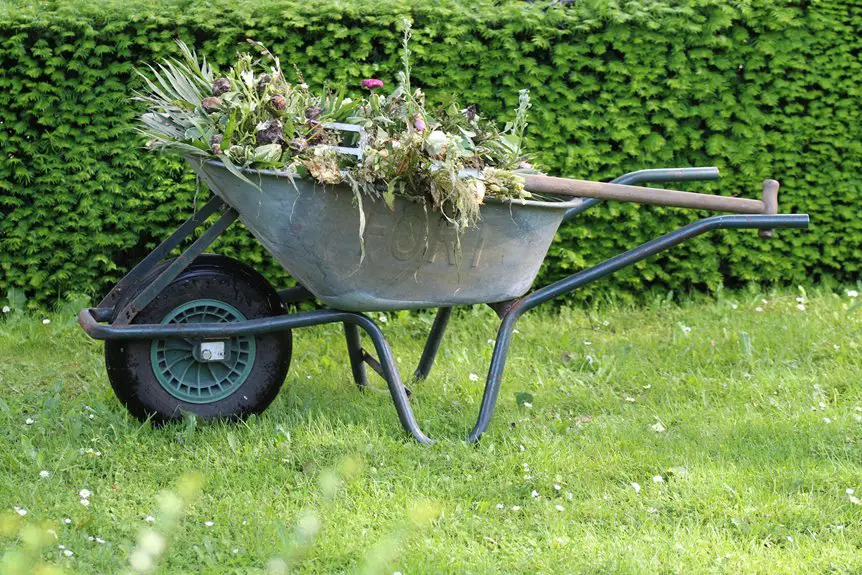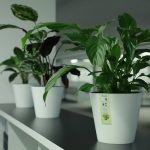For busy programmers, low-maintenance plants like the Snake Plant and ZZ Plant are perfect choices. They thrive on neglect and flourish in low light, requiring only occasional watering. Pothos adds a vibrant touch with its trailing leaves, while the peace lily offers elegance and air-purifying benefits. If you want a unique statement piece, consider a cactus. These options will enhance your workspace with minimal effort. Discover more about these stunning plants and how they can boost your environment.
Table of Contents
Key Takeaways
- Snake Plants are forgiving and thrive in various light conditions, requiring minimal watering, making them perfect for busy programmers.
- Pothos is an easy-care trailing plant that grows well in indirect sunlight and adds vibrant greenery to any workspace.
- ZZ Plants flourish on neglect, needing watering only every few weeks, ideal for those with hectic schedules.
- Spider Plants require minimal effort, filter pollutants, and enhance air quality, making them a great choice for office environments.
- Cacti demand little water and thrive in dry conditions, adding unique aesthetic appeal to programming spaces without much care.
Snake Plant: The Ultimate Survivor
When it comes to low-maintenance houseplants, the Snake Plant stands out as the ultimate survivor.
You'll love its ability to thrive in various conditions, from low light to bright, indirect sunlight. This plant's thick, succulent leaves not only add a touch of elegance to your space but also help purify the air.
You don't have to worry about frequent watering; just let the soil dry out between sessions. It's forgiving if you forget, making it perfect for your busy lifestyle.
Plus, the Snake Plant's resilience means it can handle occasional neglect without a hitch. Give it a spot in your home, and you'll find it's a reliable companion that enhances your environment effortlessly.
Pothos: The Perfect Trailing Plant
Pothos is often hailed as the perfect trailing plant for both novices and seasoned plant parents alike. Its heart-shaped leaves, available in vibrant shades of green and variegated patterns, add a touch of elegance to any space.
You'll appreciate how easy it's to care for; just place it in indirect sunlight and water when the soil feels dry. Whether you hang it in a macramé holder or let it cascade down a bookshelf, Pothos thrives in various environments.
Plus, it's known for its air-purifying qualities, making it a smart choice for your workspace. With minimal fuss, you'll enjoy the beauty and benefits of this resilient plant, allowing you to focus on your coding and creativity.
ZZ Plant: A Tough Companion
If you're looking for a plant that thrives on neglect, the ZZ plant is your go-to.
It flourishes in low light and only needs watering every few weeks, making it perfect for busy programmers.
With its tough nature, you won't have to worry about keeping it alive while you focus on your code.
Resilience in Low Light
While many plants struggle in dim environments, the ZZ plant (Zamioculcas zamiifolia) thrives, making it an ideal companion for programmers who often find themselves in low-light workspaces.
Its glossy, dark green leaves not only bring a touch of nature indoors but also absorb light efficiently, allowing it to flourish where other plants might falter. You won't have to worry about placing it near windows or bright lights; the ZZ plant adapts easily to various lighting conditions.
Plus, it won't mind if you forget it for a few days. By choosing a ZZ plant, you're not just adding greenery to your space; you're welcoming a resilient friend that can keep up with your busy, tech-driven lifestyle.
Minimal Water Requirements
As you juggle deadlines and projects, the ZZ plant proves to be a low-maintenance ally, requiring minimal water to thrive. This hardy houseplant can go weeks without a drop, making it perfect for your busy lifestyle.
Just a little care will keep it happy and healthy.
Here's what you can expect from a ZZ plant:
- Drought Tolerance: It stores water in its thick, waxy leaves, so don't worry about overwatering.
- Easy Care: Water it every 2-3 weeks, or when the soil's completely dry—simple enough, right?
- Versatile Placement: Whether in your home office or a corner of your living room, it fits anywhere without fuss.
With the ZZ plant, you can focus on your work without stressing over watering schedules.
Spider Plant: Easy to Care For and Air-Purifying
If you're looking for a plant that boosts air quality and requires minimal effort, the spider plant is your go-to choice.
It thrives in various conditions and has a simple care routine, making it perfect for busy programmers like you.
Plus, with its air-purifying properties, you'll create a healthier workspace without much hassle.
Air Quality Benefits
When you bring a spider plant into your home or workspace, you're not just enhancing the décor; you're also taking a significant step toward improving air quality.
This resilient plant is known for its ability to filter harmful pollutants, creating a healthier environment for you.
Here are some air quality benefits you can expect:
- Removes toxins: Spider plants effectively eliminate common indoor pollutants like formaldehyde and xylene.
- Increases oxygen: They release oxygen during photosynthesis, helping to freshen the air and boost your mood.
- Humidifies the air: By releasing moisture, spider plants can improve humidity levels, making your space more comfortable.
With these benefits, a spider plant is a smart choice for any programmer's workspace!
Simple Care Routine
Caring for a spider plant is a breeze, making it perfect for busy programmers who want to enjoy its air-purifying benefits without the hassle. You only need to follow a simple care routine to keep your spider plant thriving.
| Task | Frequency | Notes |
|---|---|---|
| Watering | Every 1-2 weeks | Allow soil to dry between waterings |
| Light | Bright, indirect | Avoid direct sunlight |
| Fertilizing | Monthly (spring/fall) | Use a balanced houseplant fertilizer |
| Pruning | As needed | Trim yellow leaves to promote growth |
With minimal effort, you can ensure your spider plant stays healthy and vibrant, enhancing your workspace with fresh air and green aesthetics. Enjoy the benefits without the stress!
Peace Lily: Beauty With Minimal Effort
The Peace Lily is a stunning choice for anyone seeking a touch of elegance with minimal upkeep.
This beautiful plant thrives in low light and adds a serene vibe to your space. You won't need to worry about constant attention, making it perfect for your busy lifestyle.
Here's what makes the Peace Lily a favorite:
- Elegant White Flowers: Its lovely blooms bring a sophisticated charm to any room.
- Air Purifier: It helps filter toxins from the air, promoting a healthier environment.
- Low Water Needs: Just water it when the soil feels dry, and it'll thrive effortlessly.
With its beauty and easy care, the Peace Lily is an ideal companion for any programmer looking to brighten their workspace.
Cactus: Low Water, High Impact
If you're looking for a plant that makes a bold statement while requiring minimal water, a cactus might just be the perfect choice.
These resilient plants come in various shapes and sizes, allowing you to find one that fits your style. They thrive in dry conditions, making them ideal for busy programmers like you.
Just place your cactus in bright, indirect sunlight and water it sparingly, typically every few weeks. This low-maintenance beauty adds a unique touch to your workspace without demanding much attention.
Plus, its spiky exterior can spark interesting conversations with visitors. With a cactus by your side, you'll enjoy a vibrant, hassle-free addition to your environment that showcases your appreciation for both aesthetics and practicality.
Frequently Asked Questions
Can These Plants Survive in Low-Light Conditions?
Yes, many plants thrive in low-light conditions. You'll find options like snake plants and pothos that not only survive but can also enhance your space, adding a touch of nature without demanding too much care.
How Often Should I Repot These Plants?
You should repot your plants every 1-2 years, or when they outgrow their current containers. Check for roots growing out the drainage holes, which indicates it's time for a larger pot and fresh soil.
Are These Plants Safe for Pets?
You should always check if specific plants are safe for pets. Some common houseplants can be toxic to animals, while others are completely safe. Research each plant to ensure a pet-friendly environment in your home.
What Type of Soil Is Best for These Plants?
You'll want well-draining soil, like a mix of potting soil and perlite or sand. This helps prevent root rot and keeps your plants healthy. Make sure it retains some moisture, too, for optimal growth.
How Do I Propagate These Low-Maintenance Plants?
To propagate low-maintenance plants, you can take cuttings, place them in water or soil, and keep them moist. Alternatively, some plants can be divided at the roots. Just ensure they receive adequate light.




